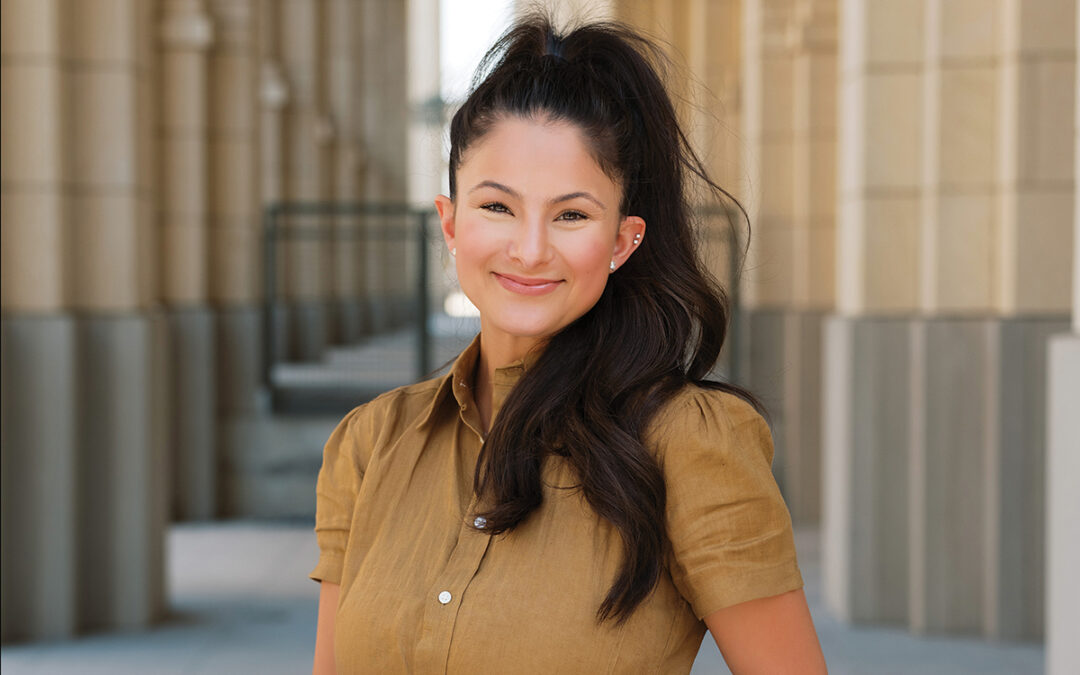Not many firefighters can say they found their way to their career through a trip to the mall, but that’s how it happened for San Antonio Fire Department Lt. Valerie Frausto, 37, now a company officer at the Gembler Road fire station. As a child, Frausto had looked up to her uncle, a firefighter who served 34 years in the department. Recalling visits to him at his station, she would listen to the radio dispatch calls sending firefighters all over the city. “I would never want to leave,” she says, “because I thought I would miss something exciting.” In those days, firefighting was “kind of a man’s world,” she says. “I never saw any female firefighters when I was younger, so I didn’t grow up thinking it was a real possibility for me.” At Incarnate Word High School, she developed an interest in biology and chemistry and after graduation in 1991 went on to study at San Antonio College and Our Lady of the Lake University toward a degree in clinical laboratory science.
While still a student, Frausto worked as a lab technician and phlebotomist at Santa Rosa Hospital and Audie Murphy Veterans Administration Hospital. “Working hands-on with people (drawing blood for testing) brought me back to my dream,” she says. During a shopping trip, she talked to a firefighter who was recruiting for the fire department at a local mall. “She was a smaller female, and that gave me hope,” says Frausto, who took a pamphlet, thought it over and decided to switch careers. “I wanted to love what I’m doing for the rest of my life,” she says, “and I knew this would be it. I was attracted to the profession because I knew I could make a difference in the lives of people when they needed help the most.” Several members of her family, including a brother-in-law and two cousins, are firefighters or police officers. “I knew the risks they took, but I also knew the satisfaction,” she says. Her firefighter uncle “was old-school and thought it was a male profession, but when I was considering it, he was the biggest influence. He told me that if I wanted anything that much, I should go for it.” As she prepared for the firefighting academy, she says, “I was surrounded by family and friends who supported me 100 percent.”
While Frausto had always been active – boating, camping and cycling in charity events are among her hobbies – she learned that she would have to prepare herself to pass the physical tests required by the San Antonio Fire Department Academy, so she added running and other exercise to her routine. “At first, I was barely able to do three or four pushups at a time, and I knew I would have to do 30 in one minute,” she says. So she pushed herself to meet the academy standards, “and when I went to take the test, I pulled it off with flying colors.” In her entering class of 47 students, Frausto was one of only three women and at 5 feet, 3 inches tall and weighing 125 pounds, she was “definitely the smallest.” It wasn’t a problem. While firefighters do have to be strong, they don’t have to be big. Academy instructors “teach you how to use your entire body weight to do the things you have to do (at a fire),” she says. “They teach you little tricks to prevent injuries. It’s always safety first.” After graduation in 2000, she was assigned to a fire station and soon was called out on her first fire. “We’d had fire practice with drill towers (in the academy), but (the instructors) knew we were new, so they kept a special eye on us and took preventive measures so we wouldn’t get hurt,” she says. As a full-fledged firefighter, “The first time I responded to a structure fire, my heart was pounding so hard, I thought it would jump out of my chest,” Frausto says. Jumping on a truck headed to a two-story house fire “in full bloom,” she wasn’t scared. “We were taught to trust in our training and have confidence in our skills,” she says. “I was excited to see what I could do.”
Promoted from firefighter basic/EMT to fire engineer in 2005, she volunteered that same year for paramedic training, toward a transfer to the department’s Emergency Medical Services (EMS) division. “What I could do as an EMT (emergency medical technician) was limited,” Frausto says. “I watched medics arrive and take over the whole medical aspect of the scene.” As a student in paramedic training at the University of Texas Health Science Center at San Antonio, she drew on her previous education and experience to graduate in 2006 with honors including dean’s list, a certificate of academic excellence and a Top of the Class Achievement award. As a state-certified and nationally registered paramedic, she says, “I could be a first responder and initiate care right away.” Her EMS experience, she believes, also was “a good education for an officer in charge of a crew.” One of the incidents that stands out from Frausto’s EMS days came when a couple drove up to her fire station, seeking help for the wife, who was having an allergic reaction to shellfish. “There was pure panic in her eyes,” says Frausto. “Her airways were closing up.” As an EMT, she wouldn’t have been able to administer medication, but as a paramedic she could give the woman epinephrine. “It brought her pulse back from cardiac arrest, and she changed before my eyes until she was smiling and laughing,” says Frausto. The couple were “so grateful. I’ve been thanked profusely so many times,” she says. “It’s very rewarding to see that your actions helped alleviate suffering or even gave someone a chance to survive.”
Competent and recognized as Frausto has been, there have been some moments that reminded her that she’s still in the minority as a woman in a male-dominated profession. “The first station I was assigned to had only one main bathroom,” she remembers, laughing. “The men were used to going in and out as they pleased, (so) I’d have to go bang on the door and ask if it was all right to come in.” Because of the long shifts firefighters work, they sleep in barracks-style dormitories at the fire station. “Sleeping in the middle of all those men was uncomfortable at first,” she says, “but as they get to know you, they treat you like a sister.” In her first years as a firefighter, women in the SAFD had to wear their hair in a ponytail or a French braid. “Even the colors of hair clips you could use were specified,” she says. At the academy, “I was sent back to get my hair cut three times until it wasn’t touching my collar.” Makeup is permitted “if it’s really conservative,” but earrings are not. Frausto’s boots had to be specially made for her in a women’s size seven. “That’s an average size for a woman,” she says, “but the company that makes them doesn’t have much call for boots that small.” From her co-workers Frausto says she has never experienced outright negativity, “but as a female, you’re constantly watched a little closer. All eyes are on you.” Whatever she does on the job, she says, “I try to go above and beyond what’s expected of me or literally die trying. I have to prove that I can pull my weight.”
Some of the extra attention she gets as a female firefighter is positive. “I see shock lots of times when I jump out of a fire truck, from children especially,” she says. “Plenty of little girls run up to tell me, ‘I want to be just like you,’ and I tell them, ‘You can do anything you want to do.’” In November 2008, Frausto was promoted to lieutenant and currently serves as a company officer. She still goes out on calls but now takes command at scenes with multiple units responding, determining what needs to be done and who will do it. “I miss being on the nozzle, actually putting out the fire, but that’s the crew’s job,” she says. “My job is the big picture, making sure that everybody’s safe and that everything’s getting done.” In the EMS division, she worked 24 hours on, sometimes getting no sleep on busy days, with 72 hours off. Now she has one 24-hour day on for two days off, getting at least a nap on most working nights. On her days off, Frausto does errands, rests and exercises “to make sure my body gets what it needs.” Holidays and weekends are the busiest times on the job, and she is often struck by how many tragedies are preventable. “So many of the medical calls are where people have been driving and drinking,” she says. “Or where people were driving with no seat belts, which amazes me.” A lot of fires start “because someone has a late-night craving for something like French fries, then they fall asleep. I always think, ‘If you’d just gone to bed, everything would have been fine.’” Unattended candles are another cause of house fires, as are space heaters set too close to curtains or bedding and overloaded surge protectors.
In her free time, Frausto makes sure to spend time with family and in the outdoor activities she loves. “From my experiences at work, I know that tragedies occur on a daily basis,” she says. “I take each day as a gift, since we never know what may happen.” A few months ago, Frausto took the captain’s exam and scored in the top six. With seniority points, that puts her in line for promotion whenever the next captain’s position opens up as retirements go through. When that happens, she says, “I’ll still be a company officer, but captains have their own house, and they’re in charge of everything there.”
Frausto intends to stay in the SAFD until her own retirement. Long before that, she hopes to go back to school and study fire science. “Regardless of how much you think you know, every situation is different,” she says. “You can never stop learning on this job.” Meanwhile, she says, “Every day I love coming to work. At a fire station your co-workers are your family away from home. From Day One, I knew it was something I wanted to do for the rest of my life.”









0 Comments